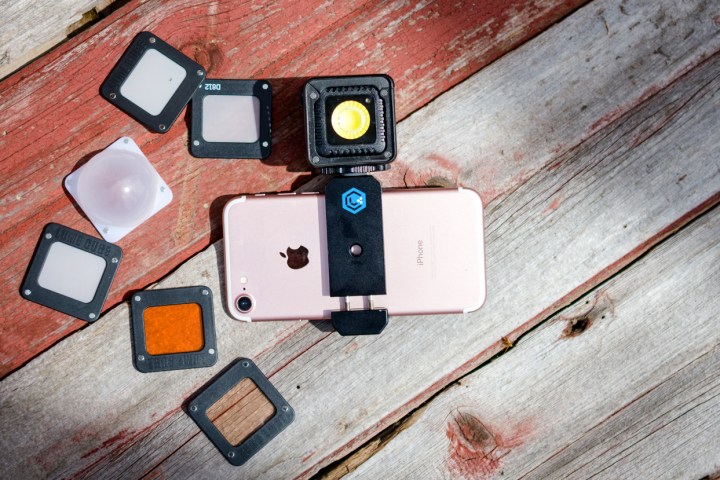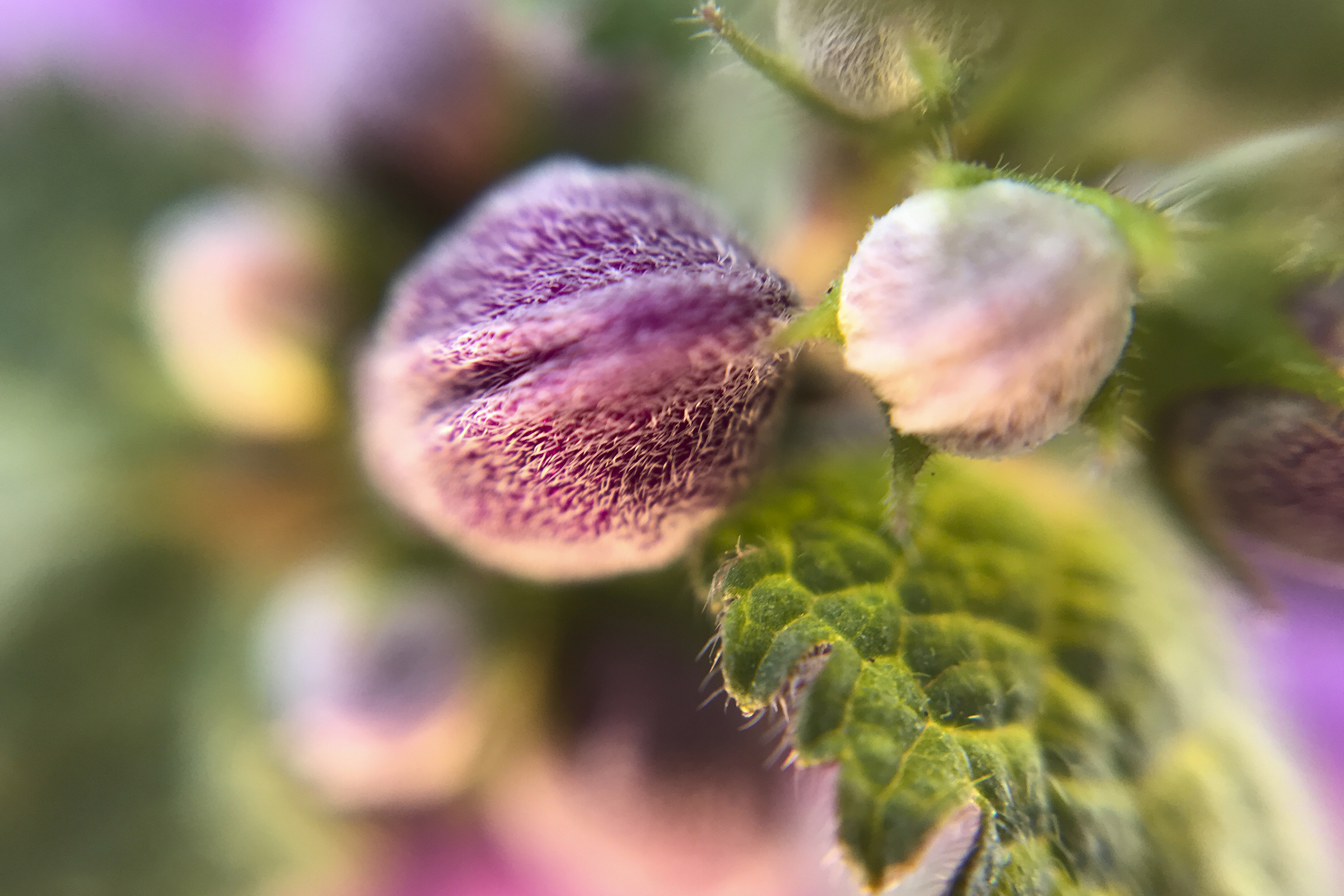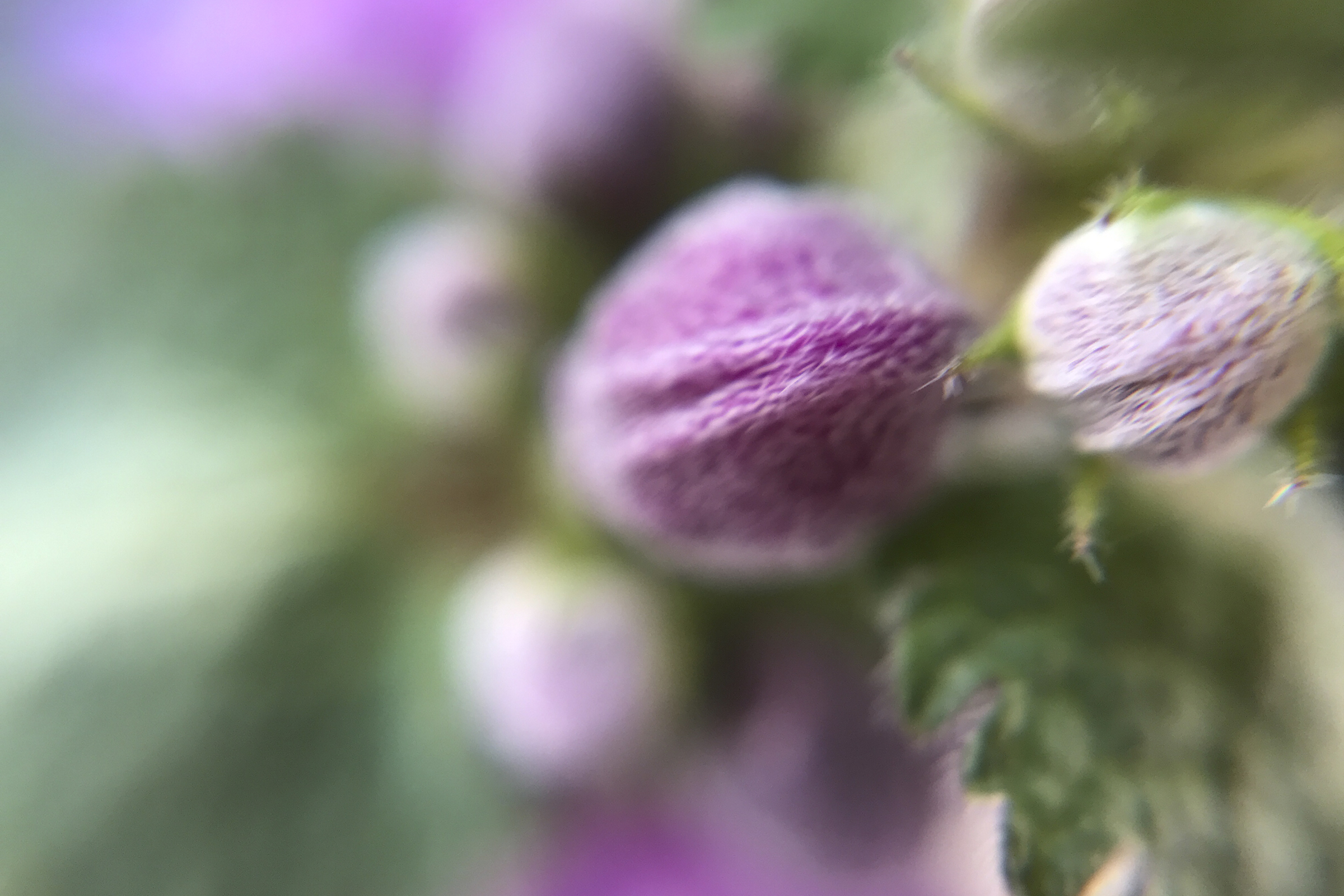
Modern smartphones put high quality cameras in your pocket, but finding equally portable lighting can be a challenge. The base Lume Cube is a photo and video light that’s built to be as portable as a phone, built around a tiny but bright LED source that is suitable for a number of different subjects. While the Lume Cube can be used as a continuous light with any camera, from DSLRs to GoPros, it also functions as a flash when paired with an iPhone. The Lume Cube Creative Lighting Kit for iPhone (tested) adds a handful of light modifiers and a clamp for mounting the light to the phone.
So just how much can an LED light not much larger than a golf ball impact your photos? Well, don’t expect it to overpower the sun, but it is as versatile as it is small. From lighting up a vlog to making snapshots pop, the little Lume Cube makes a big impact on phone photography.
Small, but tough
Even inside the optional housing, the Lume Cube measures less than two inches on each side without any modifiers attached, but it’s surprisingly strong. The company says it can survive underwater up to 100 feet deep — a limit we didn’t attempt to test — and it easily survived shallower dunks. From the metal housing to the hard plastic window protecting the LED, this light feels like it can handle a fair amount of abuse. The only downfall of all this durability is the screw-off cap that hides access to the micro USB port. This makes for a minor annoyance whenever you need to charge the light, but one that’s probably worth the waterproofing.
You can control the Lume Cube via the mobile app over Bluetooth, but thankfully that’s not the only option. Two buttons on the top of the light let cycle through the varying brightness levels and switch between flash and video modes. The buttons can he held to trigger secondary functions to activate the optical sensor mode or turn the unit off.
While the Lume Cube is available — and useful — without any accessories, the iPhone kit includes a housing, modifying gels and diffusers, and a smartphone mount. A standard 1/4-inch tripod thread can be found on the bottom of the light, too. The metal housing is required to attach the modifiers to the front of the light, but otherwise isn’t necessary.
The modifiers are held in place by magnets, making it easy to swap them or stack multiple together to mix or intensify the effects. The iPhone kit includes three flat diffusers, a dome diffuser, and two warming gels.
By using diffusers, you can get natural-looking images where the use of flash isn’t obvious.
The diffusers soften the light compared to the often unflattering look of a bare flash, while the orange gels alter the color balance to match the warmer tones of golden hour sunlight or indoor incandescent lamps. Thanks to the magnetic mount, the gels can be used with the diffusers, but keep in mind that maximum light output is reduced with each modifier that is used.
The included mounting clamp makes it easy to attach the Lume Cube straight to your phone for one-handed operation. It is made with equally durable metal construction and stretches to accommodate different phone sizes and cases, including Plus-series iPhones. The ability to use the light off-camera is one of the Lume Cube’s perks, but when you just need a simple, direct light, the clamp comes in handy.
The Lume Cube app
Setting up the app is simple and painless thanks to Bluetooth. Once connected, the app has a handful of different settings. Tapping the Lume Cube logo opens a quick menu where you can swap between flash, constant light, or two different strobe modes. Brightness, in ten increments of 150 lumens, and red-eye reduction can also be set in this menu.
While you can use any camera app with the continuous light, only the camera inside the Lume Cube app works with the flash mode. As a nice touch, switching to video mode within the app automatically sets the light to continuous. Using the Lume Cube camera is similar to the iPhone’s native app: Tap to focus and slide up and down to adjust exposure.
A second menu contains similar controls, but adds an underwater mode and an optical trigger mode. In the optical trigger mode, the Lume Cube works as a slave flash. It looks for changes in the lighting and triggers the light when a change is detected. For example, it can fire when it sees the built-in flash on the iPhone fire. Additional settings are offered for using the light with a GoPro.
The little light that could
Photographers with experience working with light know that big sources create softer light, while small sources create harder light. That means smaller light sources will have darker, more obvious shadows with a harder edge, rather than a gradual transition from highlights to shadows. One type of light isn’t necessarily better than the other — they each have their respective uses — but soft light is often a desirable effect, whereas harsh light can be a telltale sign of a cheap, bare flash. The Lume Cube is certainly very small, so as you can imagine, it’s not easy to avoid it casting a harsh light.
Put it inside a wine glass, vase, mason jar — anything with a two-inch opening — to achieve some dramatic effects.
Designed for portability, it’s just not possible to get the quality of light from the Lume Cube that you can get from a powerful studio strobe with a large soft box. But the quality of light certainly isn’t horrible and, at 1,500 lumens, is decently bright. By adjusting the intensity and using diffusers, you can still get natural-looking images where the use of flash isn’t obvious to the untrained eye.
It should also work well in conjunction with an add-on macro lens for close-ups, as here you can put the light right up close to your subject where its relative size — and therefore, softness — will increase.
In non-macro situations, the Lume Cube’s small size will make the light harsher, but it’s also possible to create fun lighting effects by using it off-camera, tucking it into places where a larger light simply wouldn’t fit. Put it inside a wine glass, vase, mason jar — anything with at least a two-inch opening — to achieve some dramatic effects.
Lighting is one of the trickiest aspects of photography to learn, but the Lume Cube makes for a relatively simple introduction to it. Continuous lights are also good for beginners because you can see how the light affects the shot before you take it, unlike with a flash.
A flash certainly has some benefits, such as freezing motion, but with the Lume Cube, we preferred to stick to constant light mode. As the app has to communicate with the flash via Bluetooth before actually taking the picture, it adds a significant amount of shutter lag between when you press the button and when the image is actually taken.
This problem isn’t exclusive to the Lume Cube; it’s the nature of Bluetooth, which just isn’t as quick as a physical connection or the wireless radio connections used in professional off-camera flashes. The phone add-on cameras like the Sony QX1 had the same problem. While the delay would be a fatal flaw if the Lume Cube was flash-only, switching to continuous mode is an easy solution when a delay would mean missing the moment. Using the continuous light on full power for extended periods can make the light run hot and will drain the battery faster. Battery life is rated for just 30 minutes at full power, but jumps to 2 hours at half power.
A creative tool for enthusiasts
Overall, the Lume Cube performs well for such a small light. It can’t overpower the sun like a professional flash, but it is bright enough to help balance outdoor lighting and fill in otherwise harsh shadows. The primary selling point, however, is its ability to add some creative depth at night, indoors, or even underwater by using it off-camera. Rather than automatically making your pictures better, it’s a light that encourages creative experimentation. As such, it may not be right for everyone, but many mobile photographers will love it.
Enthusiast phone photographers and action cam users will find plenty to love in the Lume Cube.
Beyond being one of the smallest photo/video lights on the market, the Lume Cube is the first synchronized off-camera flash for phone photographers. Thanks to its portability and versatility, it also opens up a variety of creative lighting options for DSLR and mirrorless camera users, too.
As an iPhone flash, the slow response time of Bluetooth means it won’t always be usable (although, using the optical slave mode may offer a suitable alternative for some users here), but the Lume Cube is otherwise an excellent creative tool for many photographers who don’t want the bulk of traditional lighting gear.
Few lights pack in the same number of features in such a small profile and smartphone-friendly format. The LitraTorch is similar in size and price, but doesn’t have Bluetooth or Wi-Fi for wireless control and is only rated to 30 feet underwater. While you can find cheaper but larger smartphone video lights, they aren’t waterproof or app-enabled and often aren’t as bright.

The Lume Cube, without any of the accessories, sells for $80. The company offers mounts for GoPros and drones to expand the light’s versatility. The iPhone lighting kit is an Apple Store exclusive and retails for $150, including the light, housing, smartphone mount, and adapters. This is perhaps a tad pricey for the average person, but enthusiast phone photographers and action cam users will find plenty to love.
Like add-on lenses, the Lume Cube gives users the chance to experiment creatively with their phone’s camera, to push boundaries and produce unique content in a simple and fun way without the expense and bulk of larger, dedicated cameras and lighting gear.
Editors' Recommendations
- 3 reasons why I’ll actually use Anker’s new iPhone power bank
- Stop putting your wet iPhone in rice — seriously
- I controlled this smart plant with my iPhone and I’m in love
- The iPhone 15 Pro has a killer camera feature you’ll never use
- This $130 iPhone charger is better than Apple’s official one
















